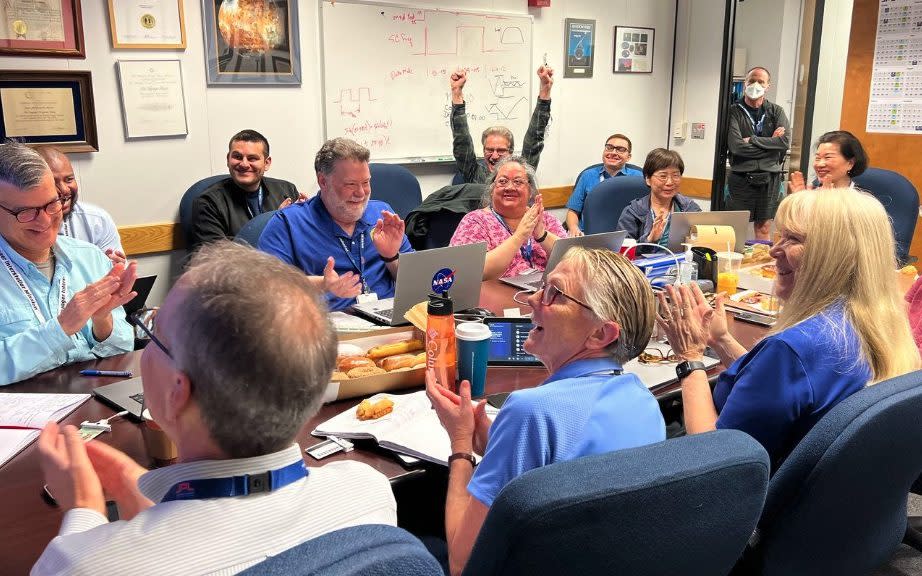When a malfunction occurs in the loneliest spacecraft in the universe, it’s not just a matter of turning it off and on again.
Voyager 1, the first human-made object to leave the Solar System in 2012, went silent in November, meaning no science or engineering data would be sent back to Earth.
The probe was relaying important data about ‘things between the stars’ and the sudden loss of communications stunned NASA.
The spacecraft is 15 billion miles away, traveling at 32,000 miles per hour, meaning that any commands sent from mission controllers take 22.5 hours to reach the tiny probe, and once they arrive, the engineering team must wait the same amount of time again for a response.
To make matters worse, Voyager 1 was built in the 1960s and 1970s; That meant experts had to comb through archives to find decades-old paper documents written by engineers who never anticipated the problems or even knew the probe would travel this far.
But this week, NASA’s Jet Propulsion Laboratory (JPL) announced that Voyager is back in operation after receiving the most impressive long-range software patch in history.
keep up the work
University of Iowa Research Scientist Bill Kurth, who has been a member of the Voyager science team since 1974, told The Telegraph: “We were all very happy to re-establish two-way communication with Voyager 1.
“The Voyager team at JPL performed a miracle by rescuing this amazing explorer, making continued scientific discovery possible.
“We now look forward to seeing the flow of scientific data from Voyager 1 in the coming weeks.”
It took NASA more than five months to resolve the problem. The initial idea in March was to give the spacecraft a ‘digital nudge’. Like a dentist blowing air over teeth to detect cavities, the NASA team sent a command asking the spacecraft to send a full memory reading back to Earth, so the damaged parts would stand out.
The resulting “nudge” bug was found in a chip in one of Voyager’s three onboard computers called the flight data subsystem (FDS), which is responsible for packaging science and engineering data before being sent back to Earth.
The glitch meant that instead of returning science, temperature and engineering data, the computer produced repetitive gibberish of binary ones and zeros, as if it were “stuck”.
Ingenious workaround
Since it was impossible to replace the faulty chip, NASA came up with an ingenious workaround that involved placing the affected code elsewhere in the FDS memory.
But to make things even more complicated, no location was large enough to hold the entire code section.
So they devised a plan to split the affected code into sections and store those sections in new locations in the computer system’s memory, while allowing them to talk to each other and work together.
After the software patch was sent out, several dozen scientists and engineers gathered in a conference room at JPL in Pasadena, California, to wait for the new signal. Approximately 45 hours after applying the fix, the team received confirmation that it was successful.

Linda Spilker, project scientist for NASA’s twin Voyager spacecraft, told the website Ars Technica that “you may have heard a pin drop” in the room as you waited for the signal. When it finally arrived there were ‘tears of relief, high fives and smiles’.
The team isn’t sure what caused the faulty chip, but they think it may have been hit by an energetic particle from space or worn out after 46 years.
Humanity’s furthest object
Voyager 1 and its sister spacecraft, Voyager 2, were launched in 1977 to study Jupiter and Saturn.
The mission has since been expanded to explore the outer limits of the Sun’s influence and beyond. Passing by Uranus and Neptune, Voyager 2 is also heading towards interstellar space.
Voyager 1 is humanity’s furthest object, and should it be intercepted by any intelligent alien civilization, it will find a gold-plated disk containing multicultural greetings, songs and photographs in 55 languages.
These include a message written in Welsh and six extinct languages.
Audio recordings include footsteps on polished floors, a human heartbeat, and someone laughing. There is also the sound of a couple kissing and a mother with her child.
The disc even contains the brainwaves of Ann Druyan, creative director of the Voyager Interstellar Message Project, when she decided to marry her husband. He described it as thoughts of someone being in love.
Nuclear battery or Radioisotope Thermoelectric Generator (RTG) powered spacecraft are the two longest operating spacecraft in history.
Voyager 1 mainly studies cosmic rays, but the team is also excited by a strange anomaly in the data they call ‘pressure front 2’; a jump in plasma density and magnetic field around the spacecraft.
NASA doesn’t know whether it came from the Sun or an event in interstellar space.
Dr. Kurth added: “I had absolutely no idea that these two spacecraft would continue to operate for over 46 years and continue to send back critical scientific information from beyond the Sun’s vast atmosphere or heliosphere.
“Voyagers are making the only in situ observations so far of ‘things between the stars,’ and these probably won’t be repeated for 30 years or more.
“We are learning about cosmic rays thought to originate from supernova explosions, the magnetic field surrounding the heliosphere, the density of plasma, and that even beyond the heliopause the Sun can influence the interstellar medium for tens of astronomical units.
“Each of these measurements raises new questions about the Sun’s galactic environment.”